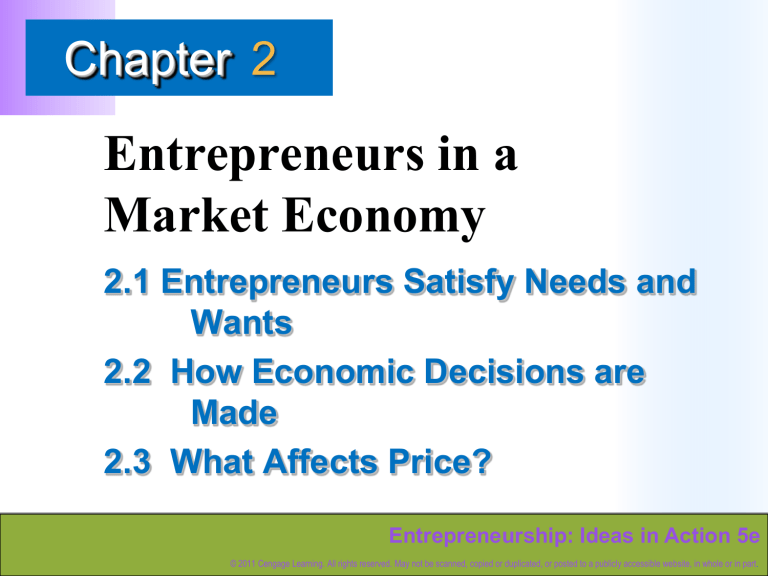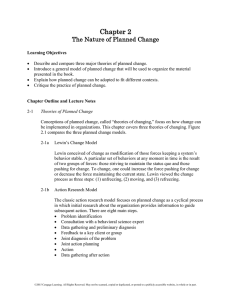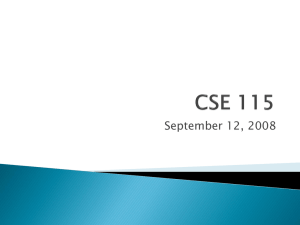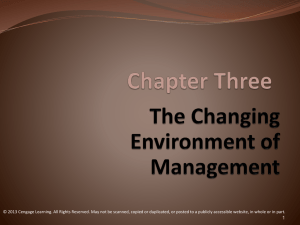
Chapter 2
Entrepreneurs in a
Market Economy
2.1 Entrepreneurs Satisfy Needs and
Wants
2.2 How Economic Decisions are
Made
2.3 What Affects Price?
Entrepreneurship: Ideas in Action 5e
© 2011 Cengage Learning. All rights reserved. May not be scanned, copied or duplicated, or posted to a publicly accessible website, in whole or in part.
Lesson 2.1
Entrepreneurs Satisfy Needs
and Wants
Goals
Distinguish between needs and wants.
Describe the types of economic
resources.
Explain the role of entrepreneurs in the
U.S. economy.
Chapter 2
Slide 2
Entrepreneurship: Ideas in Action 5e
© 2011 Cengage Learning. All rights reserved. May not be scanned, copied or duplicated, or posted to a publicly accessible website, in whole or in part.
Vocabulary
needs
wants
economic resources
Chapter 2
Slide 3
Entrepreneurship: Ideas in Action 5e
© 2011 Cengage Learning. All rights reserved. May not be scanned, copied or duplicated, or posted to a publicly accessible website, in whole or in part.
Is It a Need or a Want?
needs
things that are necessary for survival
wants
things you think you must have in order to
be satisfied
add comfort and pleasure to your life
Chapter 2
Slide 4
Entrepreneurship: Ideas in Action 5e
© 2011 Cengage Learning. All rights reserved. May not be scanned, copied or duplicated, or posted to a publicly accessible website, in whole or in part.
The role of businesses is to produce
and distribute goods and services that
people need and want.
Chapter 2
Slide 5
Entrepreneurship: Ideas in Action 5e
© 2011 Cengage Learning. All rights reserved. May not be scanned, copied or duplicated, or posted to a publicly accessible website, in whole or in part.
Needs
Maslow’s hierarchy of needs states
that:
People’s basic physiological needs must
be satisfied before they can focus on
higher level needs.
Chapter 2
Slide 6
Entrepreneurship: Ideas in Action 5e
© 2011 Cengage Learning. All rights reserved. May not be scanned, copied or duplicated, or posted to a publicly accessible website, in whole or in part.
Chapter 2
Slide 7
Entrepreneurship: Ideas in Action 5e
© 2011 Cengage Learning. All rights reserved. May not be scanned, copied or duplicated, or posted to a publicly accessible website, in whole or in part.
needs
are different for each person
vary by situation
Chapter 2
Slide 8
Entrepreneurship: Ideas in Action 5e
© 2011 Cengage Learning. All rights reserved. May not be scanned, copied or duplicated, or posted to a publicly accessible website, in whole or in part.
Wants
economic wants
a desire for material goods and services
are the basis of an economy
clothing
housing
cars
noneconomic wants
nonmaterial things
sunshine
fresh air
happiness
Chapter 2
Slide 9
Entrepreneurship: Ideas in Action 5e
© 2011 Cengage Learning. All rights reserved. May not be scanned, copied or duplicated, or posted to a publicly accessible website, in whole or in part.
Needs and Wants are
Unlimited
Needs and wants never end.
One purchase often leads to another.
Chapter 2
Slide 10
Entrepreneurship: Ideas in Action 5e
© 2011 Cengage Learning. All rights reserved. May not be scanned, copied or duplicated, or posted to a publicly accessible website, in whole or in part.
What is the difference between a need
and a want?
Chapter 1
Slide 11
Entrepreneurship: Ideas in Action 5e
© 2011 Cengage Learning. All rights reserved. May not be scanned, copied or duplicated, or posted to a publicly accessible website, in whole or in part.
Economic Resources
economic resources
the means through which goods and
services are produced
goods
products you can see and touch
services
activities that are consumed as they are
produced
Chapter 2
Slide 12
Entrepreneurship: Ideas in Action 5e
© 2011 Cengage Learning. All rights reserved. May not be scanned, copied or duplicated, or posted to a publicly accessible website, in whole or in part.
Entrepreneurs use economic resources
to create the goods and services
consumers use.
These resources are also called factors
of production
Chapter 2
Slide 13
Entrepreneurship: Ideas in Action 5e
© 2011 Cengage Learning. All rights reserved. May not be scanned, copied or duplicated, or posted to a publicly accessible website, in whole or in part.
Factors of Production
natural resources
raw materials supplied by nature
human resources
the people who create goods and services
Chapter 2
Slide 14
Entrepreneurship: Ideas in Action 5e
© 2011 Cengage Learning. All rights reserved. May not be scanned, copied or duplicated, or posted to a publicly accessible website, in whole or in part.
specialization
when individual workers focus on single tasks
each worker becomes more efficient and
productive
division of labor
divides the production process into separate tasks
workers specialize in specific tasks
the group as a whole becomes more productive
Chapter 1
Slide 15
Entrepreneurship: Ideas in Action 5e
© 2011 Cengage Learning. All rights reserved. May not be scanned, copied or duplicated, or posted to a publicly accessible website, in whole or in part.
capital resources
the assets used in the production of goods
and services
Chapter 1
Slide 16
Entrepreneurship: Ideas in Action 5e
© 2011 Cengage Learning. All rights reserved. May not be scanned, copied or duplicated, or posted to a publicly accessible website, in whole or in part.
Limited Resources
Economic resources are limited.
Individuals, businesses, and countries
compete for resources.
High demand for a limited resource drives
up the price for the resource.
Chapter 2
Slide 17
Entrepreneurship: Ideas in Action 5e
© 2011 Cengage Learning. All rights reserved. May not be scanned, copied or duplicated, or posted to a publicly accessible website, in whole or in part.
Law of Diminishing Returns
If one factor of production is increased
while others stay the same, the
resulting increase in output (product
produced) will level off after some time
and then will decline.
Chapter 1
Slide 18
Entrepreneurship: Ideas in Action 5e
© 2011 Cengage Learning. All rights reserved. May not be scanned, copied or duplicated, or posted to a publicly accessible website, in whole or in part.
List the three types of economic
resources and give an example of
each.
Chapter 1
Slide 19
Entrepreneurship: Ideas in Action 5e
© 2011 Cengage Learning. All rights reserved. May not be scanned, copied or duplicated, or posted to a publicly accessible website, in whole or in part.
Role of Entrepreneurs in the
U.S. Economy
Entrepreneurs play an important role in
the U.S. economy.
The development of small businesses
helps to ensure a strong economic
future.
Chapter 2
Slide 20
Entrepreneurship: Ideas in Action 5e
© 2011 Cengage Learning. All rights reserved. May not be scanned, copied or duplicated, or posted to a publicly accessible website, in whole or in part.
Supply and Demand
Entrepreneurs look for unmet needs to
satisfy consumer needs and wants.
Chapter 2
Slide 21
Entrepreneurship: Ideas in Action 5e
© 2011 Cengage Learning. All rights reserved. May not be scanned, copied or duplicated, or posted to a publicly accessible website, in whole or in part.
Capital Investment and Job
Creation
Entrepreneurs invest in their
communities by
contributing to the local economy
providing jobs
Chapter 2
Slide 22
Entrepreneurship: Ideas in Action 5e
© 2011 Cengage Learning. All rights reserved. May not be scanned, copied or duplicated, or posted to a publicly accessible website, in whole or in part.
Change Agents
The creation of new products can:
change the way people live
alter the way people conduct business
Chapter 2
Slide 23
Entrepreneurship: Ideas in Action 5e
© 2011 Cengage Learning. All rights reserved. May not be scanned, copied or duplicated, or posted to a publicly accessible website, in whole or in part.
What are some things entrepreneurs
contribute to the U.S. economy?
Chapter 1
Slide 24
Entrepreneurship: Ideas in Action 5e
© 2011 Cengage Learning. All rights reserved. May not be scanned, copied or duplicated, or posted to a publicly accessible website, in whole or in part.
Lesson 2.2
How Economic Decisions are
Made
Goals
Compare and contrast different types of economic
systems.
Describe the characteristics of the U.S. economy.
Explain how scarcity affects economic decisions.
Explain how business functions are used to satisfy
consumers.
Chapter 2
Slide 25
Entrepreneurship: Ideas in Action 5e
© 2011 Cengage Learning. All rights reserved. May not be scanned, copied or duplicated, or posted to a publicly accessible website, in whole or in part.
Vocabulary
capitalism
profit
economic decision making
scarcity
opportunity cost
Chapter 2
Slide 26
Entrepreneurship: Ideas in Action 5e
© 2011 Cengage Learning. All rights reserved. May not be scanned, copied or duplicated, or posted to a publicly accessible website, in whole or in part.
Economic Systems
Each economy must answer three
basic questions regarding goods and
services:
Which ones will be produced?
How will they be produced?
Whose needs and wants will they satisfy?
Chapter 2
Slide 27
Entrepreneurship: Ideas in Action 5e
© 2011 Cengage Learning. All rights reserved. May not be scanned, copied or duplicated, or posted to a publicly accessible website, in whole or in part.
Command Economy
Production decisions are made by the
government.
Few choices exist in the marketplace.
Chapter 1
Slide 28
Entrepreneurship: Ideas in Action 5e
© 2011 Cengage Learning. All rights reserved. May not be scanned, copied or duplicated, or posted to a publicly accessible website, in whole or in part.
Market Economy
Production decisions are made by
individuals and businesses.
Entrepreneurship thrives in a market
economy.
Many choices exist in the marketplace.
Chapter 1
Slide 29
Entrepreneurship: Ideas in Action 5e
© 2011 Cengage Learning. All rights reserved. May not be scanned, copied or duplicated, or posted to a publicly accessible website, in whole or in part.
Traditional Economy
Production occurs the way it has
always occurred.
Most production is consumed.
Left over production is sold or traded.
Chapter 1
Slide 30
Entrepreneurship: Ideas in Action 5e
© 2011 Cengage Learning. All rights reserved. May not be scanned, copied or duplicated, or posted to a publicly accessible website, in whole or in part.
Mixed Economy
These economies contain elements of
command and market economies.
The government is still involved in the
marketplace.
Chapter 1
Slide 31
Entrepreneurship: Ideas in Action 5e
© 2011 Cengage Learning. All rights reserved. May not be scanned, copied or duplicated, or posted to a publicly accessible website, in whole or in part.
communism
a command economic system
the government controls most of the
resources and decisions
Chapter 2
Slide 32
Entrepreneurship: Ideas in Action 5e
© 2011 Cengage Learning. All rights reserved. May not be scanned, copied or duplicated, or posted to a publicly accessible website, in whole or in part.
How does the type of economy affect
the way the basic economic questions
are answered?
Chapter 1
Slide 33
Entrepreneurship: Ideas in Action 5e
© 2011 Cengage Learning. All rights reserved. May not be scanned, copied or duplicated, or posted to a publicly accessible website, in whole or in part.
The U.S. Economic System
capitalism
the private ownership of resources by
individuals rather than by the government
individual businesses and consumers
make production decisions
also called free enterprise
Chapter 2
Slide 34
Entrepreneurship: Ideas in Action 5e
© 2011 Cengage Learning. All rights reserved. May not be scanned, copied or duplicated, or posted to a publicly accessible website, in whole or in part.
The U.S. economic system of capitalism
is based on four basic principles.
Private Property
You may own whatever you want as long as you
operate within the law.
Freedom of Choice
Government intervention occurs only when
individual decisions will bring harm to others.
Chapter 2
Slide 35
Entrepreneurship: Ideas in Action 5e
© 2011 Cengage Learning. All rights reserved. May not be scanned, copied or duplicated, or posted to a publicly accessible website, in whole or in part.
Profit
the difference between the revenues earned by
a business and the costs of operating the
business
The opportunity to earn a profit is at the heart of
the free-enterprise system.
Competition
the rivalry among businesses to sell their goods
and services
Chapter 2
Slide 36
Entrepreneurship: Ideas in Action 5e
© 2011 Cengage Learning. All rights reserved. May not be scanned, copied or duplicated, or posted to a publicly accessible website, in whole or in part.
Describe the four basic principles of
the U.S. economic system.
Chapter 1
Slide 37
Entrepreneurship: Ideas in Action 5e
© 2011 Cengage Learning. All rights reserved. May not be scanned, copied or duplicated, or posted to a publicly accessible website, in whole or in part.
Economic Choices
economic decision making
the process of choosing which needs and
wants, among several, you will satisfy
using the resources you have
Chapter 2
Slide 38
Entrepreneurship: Ideas in Action 5e
© 2011 Cengage Learning. All rights reserved. May not be scanned, copied or duplicated, or posted to a publicly accessible website, in whole or in part.
Scarcity
scarcity
occurs when there are limited resources
available to meet the unlimited needs and
wants of consumers
Scarcity forces you to make decisions
about tradeoffs.
Chapter 1
Slide 39
Entrepreneurship: Ideas in Action 5e
© 2011 Cengage Learning. All rights reserved. May not be scanned, copied or duplicated, or posted to a publicly accessible website, in whole or in part.
Opportunity Cost
opportunity cost
the value of the next-best alternative (the
one you pass up)
Chapter 1
Slide 40
Entrepreneurship: Ideas in Action 5e
© 2011 Cengage Learning. All rights reserved. May not be scanned, copied or duplicated, or posted to a publicly accessible website, in whole or in part.
What factors affect economic choices?
Chapter 1
Slide 41
Entrepreneurship: Ideas in Action 5e
© 2011 Cengage Learning. All rights reserved. May not be scanned, copied or duplicated, or posted to a publicly accessible website, in whole or in part.
Functions of Business
Production
The production function creates or obtains
products or services for sale.
Chapter 2
Slide 42
Entrepreneurship: Ideas in Action 5e
© 2011 Cengage Learning. All rights reserved. May not be scanned, copied or duplicated, or posted to a publicly accessible website, in whole or in part.
Marketing
The goal of marketing is to attract as many
consumers as possible.
The marketing mix includes:
Chapter 2
Slide 43
product
distribution
price
promotion
Entrepreneurship: Ideas in Action 5e
© 2011 Cengage Learning. All rights reserved. May not be scanned, copied or duplicated, or posted to a publicly accessible website, in whole or in part.
Management
The duties of management include:
Chapter 2
Slide 44
setting goals
deciding on responses to competition
solving problems
overseeing employees
evaluating business activities
Entrepreneurship: Ideas in Action 5e
© 2011 Cengage Learning. All rights reserved. May not be scanned, copied or duplicated, or posted to a publicly accessible website, in whole or in part.
Finance
Financial duties include:
determining the amount of capital needed
determining how capital will be obtained
managing the financial records of the business
Chapter 2
Slide 45
Entrepreneurship: Ideas in Action 5e
© 2011 Cengage Learning. All rights reserved. May not be scanned, copied or duplicated, or posted to a publicly accessible website, in whole or in part.
What are the functions of business?
Chapter 1
Slide 46
Entrepreneurship: Ideas in Action 5e
© 2011 Cengage Learning. All rights reserved. May not be scanned, copied or duplicated, or posted to a publicly accessible website, in whole or in part.
Lesson 2.3
What Affects Price?
Goals
Recognize how supply and demand
interact to determine price.
Describe how costs of doing business
affect the price of a good or service.
Explain the effect of different market
structures on price.
Chapter 2
Slide 47
Entrepreneurship: Ideas in Action 5e
© 2011 Cengage Learning. All rights reserved. May not be scanned, copied or duplicated, or posted to a publicly accessible website, in whole or in part.
Vocabulary
supply
demand
equilibrium price and quantity
fixed costs
variable costs
marginal benefit
marginal cost
economies of scale
Chapter 2
Slide 48
Entrepreneurship: Ideas in Action 5e
© 2011 Cengage Learning. All rights reserved. May not be scanned, copied or duplicated, or posted to a publicly accessible website, in whole or in part.
How Much Is Enough?
supply
how much of a good or service a producer
is willing to produce at different prices
demand
the quantity of a good or service that
consumers are willing to buy at a given
price
Chapter 2
Slide 49
Entrepreneurship: Ideas in Action 5e
© 2011 Cengage Learning. All rights reserved. May not be scanned, copied or duplicated, or posted to a publicly accessible website, in whole or in part.
Chapter 2
Slide 50
Entrepreneurship: Ideas in Action 5e
© 2011 Cengage Learning. All rights reserved. May not be scanned, copied or duplicated, or posted to a publicly accessible website, in whole or in part.
Chapter 2
Slide 51
Entrepreneurship: Ideas in Action 5e
© 2011 Cengage Learning. All rights reserved. May not be scanned, copied or duplicated, or posted to a publicly accessible website, in whole or in part.
demand elasticity
when the demand of a product is affected by
its price
elastic demand
when a change is price creates a change in
demand
inelastic demand
when a change in price creates very little
change in demand
Chapter 2
Slide 52
Entrepreneurship: Ideas in Action 5e
© 2011 Cengage Learning. All rights reserved. May not be scanned, copied or duplicated, or posted to a publicly accessible website, in whole or in part.
When Supply and Demand
Meet
equilibrium price and quantity
the point at which the supply and demand
curves meet
Chapter 2
Slide 53
Entrepreneurship: Ideas in Action 5e
© 2011 Cengage Learning. All rights reserved. May not be scanned, copied or duplicated, or posted to a publicly accessible website, in whole or in part.
Chapter 2
Slide 54
Entrepreneurship: Ideas in Action 5e
© 2011 Cengage Learning. All rights reserved. May not be scanned, copied or duplicated, or posted to a publicly accessible website, in whole or in part.
What effect do supply and demand
have price?
Chapter 1
Slide 55
Entrepreneurship: Ideas in Action 5e
© 2011 Cengage Learning. All rights reserved. May not be scanned, copied or duplicated, or posted to a publicly accessible website, in whole or in part.
Costs of Doing Business
fixed costs
costs that must be paid regardless of how
much of a good or service is produced
variable costs
costs that fluctuate depending on the
quantity of the good or service produced
Chapter 2
Slide 56
Entrepreneurship: Ideas in Action 5e
© 2011 Cengage Learning. All rights reserved. May not be scanned, copied or duplicated, or posted to a publicly accessible website, in whole or in part.
Fixed costs will be incurred regardless
of the level of sales.
marginal benefit
measures the advantages of producing one
additional unit of a good or service
marginal cost
measures the disadvantages of producing
one additional unit of a good or service
Chapter 2
Slide 57
Entrepreneurship: Ideas in Action 5e
© 2011 Cengage Learning. All rights reserved. May not be scanned, copied or duplicated, or posted to a publicly accessible website, in whole or in part.
economies of scale
the cost advantages obtained due to
expansion
A lower average cost per unit is achieved
through increased production because
costs can be spread over an increased
number of units.
Chapter 2
Slide 58
Entrepreneurship: Ideas in Action 5e
© 2011 Cengage Learning. All rights reserved. May not be scanned, copied or duplicated, or posted to a publicly accessible website, in whole or in part.
How do the costs of doing business
affect prices?
Chapter 1
Slide 59
Entrepreneurship: Ideas in Action 5e
© 2011 Cengage Learning. All rights reserved. May not be scanned, copied or duplicated, or posted to a publicly accessible website, in whole or in part.
Market Structure and Prices
Perfect Competition
Characteristics of perfect competition
include:
Chapter 2
Slide 60
a very large number of businesses
nearly identical products
many well-informed buyers
difficult to raise prices
consumers have more control over the market
businesses can leave or enter the market easily
Entrepreneurship: Ideas in Action 5e
© 2011 Cengage Learning. All rights reserved. May not be scanned, copied or duplicated, or posted to a publicly accessible website, in whole or in part.
Monopolistic Competition
Characteristics of monopolistic competition
include:
Chapter 2
Slide 61
a large number of independent businesses
goods and services that are somewhat different
each business has a small share of the market
prices are determined competitively
differentiating products is important
businesses can easily enter or leave the market
Entrepreneurship: Ideas in Action 5e
© 2011 Cengage Learning. All rights reserved. May not be scanned, copied or duplicated, or posted to a publicly accessible website, in whole or in part.
Oligopoly
Characteristics of an oligopoly include:
a small number of businesses that gain the
majority of total sales revenues
the goods are similar and are close substitutes
businesses can influence prices
it is hard to enter the market
Chapter 2
Slide 62
Entrepreneurship: Ideas in Action 5e
© 2011 Cengage Learning. All rights reserved. May not be scanned, copied or duplicated, or posted to a publicly accessible website, in whole or in part.
Monopoly
where there is only one provider of a good or
service
Because of a lack of competition,
companies can charge whatever price
they like.
Barriers that make it difficult for new
businesses to enter a market is a primary
reason that monopolies exist.
Chapter 2
Slide 63
Entrepreneurship: Ideas in Action 5e
© 2011 Cengage Learning. All rights reserved. May not be scanned, copied or duplicated, or posted to a publicly accessible website, in whole or in part.
How does the market structure affect
the price of a good or service?
Chapter 1
Slide 64
Entrepreneurship: Ideas in Action 5e
© 2011 Cengage Learning. All rights reserved. May not be scanned, copied or duplicated, or posted to a publicly accessible website, in whole or in part.
PERFORMANCE COMPENTENCIES
An understanding of the topic must be evident
The topic should be presented in a logical manner
All team members must contribute to the
presentation
Arguments should be persuasive and relevant to
the topic
Questions must be answered effectively
Chapter 2
Slide 65
Entrepreneurship: Ideas in Action 5e
© 2011 Cengage Learning. All rights reserved. May not be scanned, copied or duplicated, or posted to a publicly accessible website, in whole or in part.
GIVE IT A TRY
Working with team members, research
the topic and prepare to present either
an affirmative or negative argument.
Draw to determine whether you will
present an affirmative or negative
argument.
Finalize your preparations in five
minutes.
Chapter 2
Slide 66
Entrepreneurship: Ideas in Action 5e
© 2011 Cengage Learning. All rights reserved. May not be scanned, copied or duplicated, or posted to a publicly accessible website, in whole or in part.
You may use prepared notes during the
preparation and presentation. In addition,
each team member will be given two blank
note cards for recording notes that can be
used during the preparation and
performance of the presentation.
Information may be written on both sides
of the note cards.
Chapter 2
Slide 67
Entrepreneurship: Ideas in Action 5e
© 2011 Cengage Learning. All rights reserved. May not be scanned, copied or duplicated, or posted to a publicly accessible website, in whole or in part.
No reference materials, visual aids, or
electronic devices may be brought to or
used during the preparation or
presentation.
Chapter 2
Slide 68
Entrepreneurship: Ideas in Action 5e
© 2011 Cengage Learning. All rights reserved. May not be scanned, copied or duplicated, or posted to a publicly accessible website, in whole or in part.
Make the presentation to your class. The
presentation should last no longer than
five minutes.
Be prepared to answer questions after
your presentation.
Chapter 2
Slide 69
Entrepreneurship: Ideas in Action 5e
© 2011 Cengage Learning. All rights reserved. May not be scanned, copied or duplicated, or posted to a publicly accessible website, in whole or in part.





